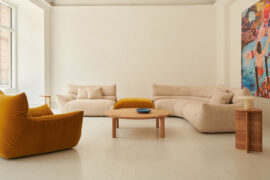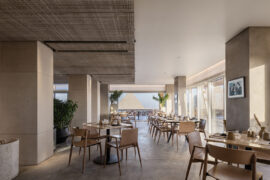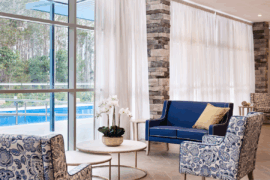The Wilson Architects-designed Learning Hub at St. Andrew’s Anglican College represents a new approaches to educational best practice in design.
St Andrew’s Anglican College has been transformed from being disparate to, today, celebrating cohesion.
The concept of a quiet learning space that is designed to accommodate concerts seems like antinomy. And yet, this was what Wilson Architects was asked to do when they were engaged to design the new Learning Hub at St. Andrew’s Anglican College on the Sunshine Coast.
The rapidly growing school was in need of additional capacity and infrastructure, but at the same time, there was no one function that could be pinned down as necessary. Instead, the school really needed a building that could act as many buildings in one: staff headquarters, student lounge, professional development care, outdoor learning area and both a primary and a secondary school library.
Symbolically and sensibly, the two-storey learning centre sits between the primary and secondary campuses of St. Andrew’s College. Necessarily, the interior is designed to be as accommodating as possible to all ages and needs, from kindergarten through to the mature needs of staffers. Each individual area has been imbued with multiple uses, such as a tiered seating area for student collaboration that can also double as an amphitheatre-like setting for concerts.
The Hub is the first manifestation of the college’s desire to move towards a more collaborative style of learning, and is more akin to a university facility than it is to a typical secondary school setting – not to mention primary school. Trials were undertaken prior to and during the design phase of the project that informed the layout, look and feel of spaces within the building, to pre-empt and accommodate the way students would use them. A strategy and sequence has also been set up for the Hub’s future construction stages.
“[The space has shifted the focus towards student-centred learning, as opposed to concentrating on teachers and their classrooms,” says Hamilton Wilson, managing director at Wilson Architects. “[It] has given students a real sense of ownership of the space and their learning.
“The school has been transformed from being very disparate to extremely cohesive, with a pulsing heart of activity at its centre.”
To foster the desired sense of welcome and inclusivity, the interior scheme incorporates ‘warm’ materials, such as the extensive use of dark woods along the ceilings and several of the bench seating arrangements, and the use of earth-toned carpets. Large glass panels line the periphery and are used in place of full walls at certain points within the building, contributing a sense of light and transparency to the Hub.
At the heart of this new learning portal is a furniture scheme that brings the ‘flexibility’ of the brief to life. Outside the classroom, this is evidenced in a mix of hard and soft furnishings, and a balance of group work stations and focused learning areas for individual study. Inside the classroom, the traditional formula is lent an adaptive twist, with mixed chair heights and moveable desks that can be reconfigured according to the needs of the day.
Ultimately, the most important critics of such spaces come from within the student body itself. According to St. Andrew’s Anglican College principal Chris Ivey, the Learning Hub has been seamlessly adopted within the gamut of daily activity.
“I have spent chunks of time each day in the Hub, observing the way our students are using the facility, and it is wonderful to see them using it as if it has always been there,” he says.
INDESIGN is on instagram
Follow @indesignlive
A searchable and comprehensive guide for specifying leading products and their suppliers
Keep up to date with the latest and greatest from our industry BFF's!

Welcomed to the Australian design scene in 2024, Kokuyo is set to redefine collaboration, bringing its unique blend of colour and function to individuals and corporations, designed to be used Any Way!

The undeniable thread connecting Herman Miller and Knoll’s design legacies across the decades now finds its profound physical embodiment at MillerKnoll’s new Design Yard Archives.

A curated exhibition in Frederiksstaden captures the spirit of Australian design

For Aidan Mawhinney, the secret ingredient to Living Edge’s success “comes down to people, product and place.” As the brand celebrates a significant 25-year milestone, it’s that commitment to authentic, sustainable design – and the people behind it all – that continues to anchor its legacy.

Curated by the Indesign editorial team and hosted at leading showrooms, the Design Discussions series provided thoughtful reflection and debate on key issues shaping the industry.

Whether you’re an architect, interior designer or student eager to learn, the 2025 Design Discussion series at Saturday Indesign will inspire fresh perspectives. Check out the schedule now!
The internet never sleeps! Here's the stuff you might have missed

Pedrali’s Nemea collection, designed by Cazzaniga Mandelli Pagliarulo, marks 10 years of refined presence in hospitality and commercial spaces around the world. With its sculptural timber form and enduring versatility, Nemea proves that timeless design is never out of place.

The new Heritage Loom Collection weaves past and present together to capture the spirit of iconic fabric construction

Inspired by an unthinkable design challenge on Sydney Harbour, Materialised’s ingenuity didn’t just fuse acoustic performance with transparent finesse – it forever reimagined commercial curtain textiles by making the impossible possible.